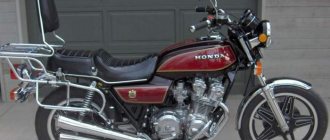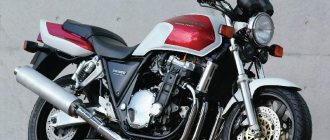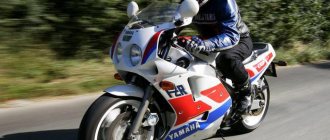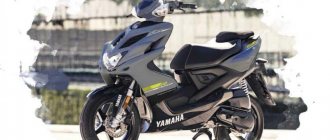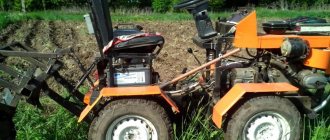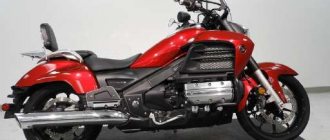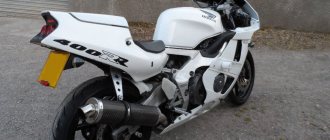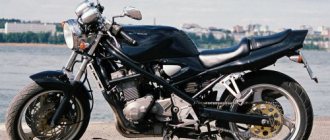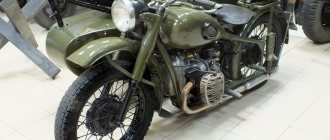Dnepr MT 10
Heavy-duty motorcycles are quite rare today, but in Soviet times they were produced in a huge range. Consequently, the Soviet motorcycle Dnepr MT 10, which is available with a sidecar included, is considered one of the best representatives. The presented model is distinguished by excellent power and the ability to transport a driver and two passengers in a stroller. Also, the dimensions of the stroller allow you to transport cargo weighing up to 260 kg. The manufacturer of this miracle is considered to be the Kiev Motorcycle Plant, but the motorcycle cannot be called completely unique. Its design and design features were borrowed from a German model produced during the Second World War.
- Huge power;
- Load capacity;
- High build quality;
- Simple design;
- Affordable price.
- Difficult to manage;
- Huge weight of 335 kg;
- High fuel consumption;
- Weak light.
As a result, the motorcycle became almost ideal for the domestic consumer; the Dnepr MT 10 could move along the road with any surface and transport heavy loads, even of a voluminous type. The main feature of the new model was the installation of reverse gear in the gearbox. Unfortunately, the motorcycle’s enormous weight of 335 kg does not allow it to move quickly, so the maximum speed is limited to 105 km/h. The MT motorcycle also had quite high fuel consumption; on average, it consumed 8 liters per 100 km. The MT 10 model has become one of the best in the Dnepr motorcycle line, the previous MT 9 model was produced since 1971, the newer Dnepr 11 began production only in 1985.
K-650, K-750, K-750M, M-72N
“Please tell us about the main differences between the models of heavy motorcycles produced by the Kyiv Motorcycle Plant and the interchangeability of their main components,” A. Ksenofontov from Donetsk, B. Petuchenko on behalf of a group of motorcycle enthusiasts from Poltava and other readers made this request to the editor.
The answer is given by design engineer of the Kyiv Motor Plant V.F. SVYATNENKO.
Heavy-duty motorcycles with sidecars are produced in two factories: Kiev and Irbit. The development of machine design at both enterprises proceeded almost simultaneously, so that their main characteristics were almost the same, and the number of interchangeable components and parts was constantly growing.
The first model of the famous heavy motorcycle, the M-72, was mastered by the people of Kiev in 1951, and in 1957 the plant began producing a more advanced machine, the M72N. It featured improved finishing, a linkage fork with spring-hydraulic shock absorbers, wheels with aluminum hubs, adjustable roller bearings and reinforced spokes. The brakes had a mechanism to adjust the position of the pads.
In 1960, production of the next model, the K-750, began. Thanks to an increase in engine power from 22 to 26 hp. With. a motorcycle with a sidecar could reach speeds of up to 90 km/h. Hydraulic shock absorbers for wheels (including strollers) and rubber springs for the stroller body ensured a smoother ride than previous models. In addition, the reliability and durability of the chassis and transmission components (front fork, gearbox, wheels) and mufflers have been increased. An important advantage of the K-750 is the unification of its components and parts with the machines of the Irbit plant.
Four years later, a modernized motorcycle model began rolling off the assembly line, designated K-750M. The lever front fork has given way to a telescopic one, and the wheels have a labyrinth seal. A gearbox with a closed foot shift mechanism and a length-adjustable driveshaft have significantly improved transmission performance.
Further improvement of the motorcycle was associated with a significant change in the engine. The fact is that in the lower-valve engine used on Kyiv motorcycles, the possibilities for increasing liter power had already been exhausted. Therefore, for the new Dnepr K-650 model, the designers created an engine with overhead valves, which, despite the smaller displacement (650 cm3), develops a power of 32 hp. With. at relatively low crankshaft speeds (5200 rpm). To increase the reliability and durability of the engine, the composite crankshaft was replaced with a more durable cast one, and the roller bearings of the connecting rods were replaced with liners borrowed from the Moskvich-407 car. Thanks to this and the new lubrication system, the time between repairs of the crank mechanism increased to 40 thousand kilometers, and the repair itself was significantly simplified. The K-650 motorcycle with a sidecar reaches speeds of up to 105 km/h and consumes 5.8 liters of gasoline per 100 km (at 50-60 km/h).
In 1971, this model was modernized and received the designation "Dnepr" MT-9. It is equipped with a new gearbox with reverse gear, which significantly increases the maneuverability of the motorcycle. In addition, the gear shift pedal, interlocked with the clutch release mechanism, new steering and direction indicators made it easier to control the motorcycle.
Nowadays, in terms of its technical parameters, the Dnepr is at the level of foreign cars of its class. It is distinguished by its maximum engine power, which is designed to provide the greatest torque at relatively low crankshaft speeds. This is a necessary condition for a car that is used mainly by rural people and residents on heavy dirt roads.
The table, which will help in choosing spare parts, gives an idea of the interchangeability of the main components and assemblies of Kyiv motorcycles.
It shows the components of the currently produced Dnepr MT-9 motorcycle and shows the possibility of their use on machines of previous releases if the following conditions are met (their numbers are given in the corresponding columns): 1 - with replacement of the exhaust system; 2 - with shortening of the cardan shaft on the hinge side; 3 — assembled with a shield; 4 - with a corresponding change in the length of the driveshaft; 5 - you need to plug the breather inlet fitting. The “+” sign indicates complete interchangeability, the “-” sign indicates the impossibility of replacement.
Technical characteristics of the motorcycle Dnepr MT 10
The main technical characteristics of a motorcycle are the engine performance. The engine is a four-stroke engine with two valves and two cylinders, the valves are located at the top. The new product was distinguished by the presence of good traction, which is provided by a volume of 649 cm3. Power was 36 hp. Fuel injection was made possible thanks to two K-301D carburetors.
Electricity was generated using an alternating current generator with a voltage of 12 volts. Moto Dnepr MT 10 had excellent torque, reaching 46 Nm. At maximum acceleration at high power, the bike reached up to 5,800 rpm. The kit included a rechargeable battery; if desired, you can add two batteries.
Five random motorcycles:
RUB 262,000*
Honda CRF 450L 2018
Benelli TNT 135 2017
RUB 565,000*
Triumph Bonneville 2010
Paton PG 500 R 2000
Norton Commando 961 S.E. 2010
Appearance
The Kiev plant decided to improve the appearance of the MT 10 36 motorcycle; technical characteristics now suggested the presence of levers at the end, the passenger footrests now reclined, and union nuts appeared on the exhaust pipes. Next, the manufacturer decided to improve the existing MT 10, the modernization took place in 1985 and received a number of changes in technical terms. Today you can buy MT 10 in the following sizes:
- length 2430 mm;
- width 1680 mm;
- height 1080 mm;
- wheelbase 1500 mm;
- ground clearance 125 mm.
Externally, the Soviet heavyweight was restrained and did not have a special design; then it was not customary to install plastic and other decorative elements; the main emphasis was on quality and simplicity of design.
It was in 1985 that the motorcycle received major changes; the MT 10 engine increased power from 32 to 36 horses. Since then, the device has become officially known as the Dnepr MT 10-36. In order to improve the motorcycle, the manufacturer began to produce it in accordance with GOST, as a result, safety was significantly improved and external noise was reduced. Safety has improved in particular due to changes to the front brake, which now has two pads. The use of clamps on gas hoses helped provide additional fire protection for the motorcycle.
Now the Dnepr MT 10 with a sidecar was used with a different oil change system. It is directly added to gasoline after each refueling. This helps directly provide lubrication to the internal components. Electrical equipment receives a huge advantage; the manufacturer was able to install self-oxidizing wires, which ensure stable and durable operation of all electrical devices. Also, a special wiring system made it possible to refuse the installation of other unnecessary devices.
The gearbox is set to 4 speeds, there is a reverse speed, and a dry clutch with two discs helps ensure smooth and sensitive shifting. At that time, all Soviet motorcycles were equipped with air cooling, so the MT 10 was no exception. The suspension of the motorcycle is of quite high quality, the excellent design makes it possible to get good handling on the road and cross-country ability over uneven terrain. In particular, this is due to the presence of a sidecar, which will prevent the motorcycle from turning over at high speed.
Despite the fact that the Dnepr motorcycle with a sidecar is no longer produced, many still actively use the existing samples. They show good quality, the engine is durable and easy to maintain. If desired, you can notice many changes in appearance and design, which is called custom Dnepr MT 10.
"Dnepr", a new look at the old unit
It is no secret that the Dnepr motorcycle has developed an image of a rural motorcycle over more than half a century of history. And it is true. Due to its unpretentiousness, “indestructibility”, maintainability, indifference to off-road conditions, etc., he became the first guy in the village. What else could you use to transport hay, firewood, moose and other domestic animals? It is worth mentioning that the Dnepr was heavily used by the traffic police, as well as in government escorts, accompanying the country's top officials in the 60s of the last century. But his element remains the countryside, where he is like a duck to water.
Years have passed... There is no longer that country with those top officials, nor that traffic police, nor collective farms, and even the existence of the Kyiv Motorcycle Plant itself is now in question, but the Dnepr motorcycles are still alive, still smoking the sky and rattling with their boxers. You can increasingly see them now, having broken with their rural past, washed, shaved, undergone major treatment and a facelift. And such specimens are no longer stored in rickety sheds, but in heated stone rooms. And the purposes of travel and destinations have changed somewhat. Now these are bike rallies, retro parades, and Sunday promenades.
A long-standing passion for old school, as well as a suddenly awakened interest in the world of motorcycles, led me to the idea of channeling my creative energy into garage customization and trying to remake a motorcycle for myself. This idea is not original and occurs periodically among millions of people around the world. In my case, it was formed into the following: take a middle-aged, inexpensive, well-known motorcycle and restore it to working condition. At the same time, preserve and emphasize the original character of the motorcycle as much as possible, only taking a slightly different look at its appearance, thereby individualizing it.
At that time, I had a vague idea about motorcycles and everything connected with them, and it was decided to start with the domestic motorcycle industry. And one day, when I accidentally saw a Dnepr passing by on the street and heard the sound of its engine, I realized that if I slightly corrected its appearance, I could get a nice vintage thing.
“Dnepr” initially has its own charisma, brutal character, the spirit of the era, and I really liked it. Soon the black iron horse stood in my garage, awakening wild animal instincts with its very appearance. I just wanted to saddle him and rush to the ends of the world. But it was -20°C outside at the time, and I had no idea what it was like to drive a motorcycle.
So, I got a motorcycle “Dnepr” MT 10-36, 650 cm3, produced in 1982. Its peculiarity was that everything in it (frame, tank, fenders, front and rear headlights, saddle, speedometer, etc.) with the exception of the engine, was from an earlier model - “Dnepr” K650. And this greatly facilitated my task, because, in my opinion, this was the last model, the design of which still retained those proportions, features and genes from the progenitor of all “Urals” and “Dneprs” - the BMW R71.
Due to the lack of any knowledge about the technical structure of the motorcycle at the time of purchase, I understood that the only area where my creativity could translate into any result was working on the appearance. Therefore, I initially looked for an option that had already undergone a major engine overhaul and was in good technical condition. And this one was found. In my case, a completely standard four-stroke engine is installed, carburetor, two-cylinder with opposed cylinders, air-cooled. I replaced K63 carburetors with more modern K68 ones and installed electronic ignition.
I started working on the appearance with the wings and color changes. The image of a rural motorcycle became the starting point for the color scheme. The harmonious combination of black and gold is more typical of something elegant, luxurious, and sporty. By using these colors on the Dnepr, I deliberately went against its “rural style”, trying to show that, if desired, a “country guy” can look urban.
But color alone was not enough here. It was urgently necessary to lower the wings. In my opinion, massive “raised” fenders over narrow wheels were the main mistake of Soviet designers of those years. And this is perfectly confirmed by the same BMW R71. There is nothing wrong with his wings, which is why the motorcycle as a whole looks harmonious. It is clear that practicality here prevailed over form, but in my approach it should be rather the other way around. It turned out that this is not so difficult to do, just drill somewhere, trim somewhere, and add additional fasteners somewhere, and that’s it, immediately the silhouette of the motorcycle became more proportional and solid. Further operation showed that in urban conditions the practical side was also not affected.
From the general (silhouette and color) it was necessary to move on to the specific, that is, smaller elements and details that reveal and express, all together and each individually, the character of the motorcycle. I preferred wide chrome “stripes” in the center to the white edges on the wings (as was the case in the original livery). They became an excellent support for the whitewalls that appeared on the tires.
The rubber “burdock” of the saddle, which initially turned out to be quite successful in shape and comfort, was additionally spring-loaded by me and trimmed with burgundy leather. In my case there is only one saddle, but there is also a second one for the passenger. It can be installed in standard places if necessary. For support, the steering grips are also covered in leather, as well as a small case for keys (a necessary option for domestic motorcycles).
The Soviet origin and military past of the Dnepr makes it logical and justified to use military and civilian instruments, objects, and paraphernalia of those times on them. They themselves carry their own unique aesthetics of old things, fit perfectly and complement the overall concept of old school.
The headlight itself is beautiful in design. It has a beautifully aged speedometer built into it with odometer knuckles and yellow and orange backlighting. The fog lights with yellow glass were taken from a VAZ car. The voltmeter is from the Il-28 bomber, but having learned that its dial has a special coating, which over time begins to emit a radioactive background, I got rid of it. A low-pitched signal from the Volga, its locomotive rumble to match its appearance. The soldier's bowler hat became an excellent place to store pre-war pilot glasses. All these little things create and emphasize the character of the old, “iron” motorcycle.
I don’t really like my native one (Kiev Motorcycle Plant). Therefore, for my “Dnepr” I developed my own. I took as a basis the image of wings generally accepted in the automoto industry, as well as a five-pointed star as a symbol of the era from which this motorcycle came.
The whole process was like an exciting game. The search for the necessary items and spare parts attracted many new, unknown people with their memories of their youth. And the motorcycle became not just a means of transportation, but something more.
I must say that those few months that I spent in the garage working on the motorcycle became a real school for me, a course for a young fighter to immerse himself in the world of motorcycles. Painting technology, skills in working with metal, understanding the principles of operation and structure of a motorcycle (adjusting carburetors, adjusting gaps and ignition), as well as simply learning to drive, all this has enriched and made my life brighter and more interesting.
During the season I drive my Dnepr every day and with breaks of one or two weeks.
His trust in me, and mine in him, arose gradually. And since then, the emotions that he gives during every trip defy any epithets. After breaks in travel, he reminds me of a free bird released from captivity. And all its technical and constructive imperfections only add bright colors to the monotony and dullness of everyday life. Partner for a trip around the world > 5 June 2014 19:47
History of creation
In the post-war years, against the backdrop of general devastation, it was necessary to restore the production sector. The Kiev Motorcycle Plant was among the first to restore the production process and, despite enormous difficulties, new equipment began to roll off the assembly line.
In 1947, the Dnepr motorcycle plant began to develop new three-wheeled motor vehicles. Production expanded and after 2 years the plant’s staff was joined by hundreds of representatives from another company, which was very useful when planning the production of M-72 motorcycles. This equipment was equipped with a four-stroke two-cylinder engine. It became very popular, and therefore the decision was made to create a new, improved model, the M-53.
M-72 motorcycle with a DP machine gun in the motorcycle museum
Since 1956, production of the modernized K-750SM and M-53S motorcycles began. They were produced until 1970.
Since 1967, the plant began producing the first batch of Dnepr motorcycles. It was equipped with a two-cylinder engine with a capacity of 650 cc. cm and power 32 hp. Large production volumes gave rise to the expansion of production facilities and their re-equipment.
In 1974, a more modern model, the Dnepr MT-10, began production. After 3 years, MT-10-38 motorcycles were produced with increased engine power, they were more comfortable and practical.
The popularity of the motorcycle, including abroad, contributed to the start of production of the Dnepr 11 and Dnepr 16 motorcycles in 1985.
The legendary Ural motorcycle in 2021: engine, gearbox, configurations and prices
The manufacturer of motorcycles under the Ural brand is well known not only to domestic motorcycle enthusiasts, but also far beyond Russia.
Today, the main sales market for Ural two-wheeled vehicles is Europe, the USA and Canada. According to estimates, only 3% of motorcycles of this brand produced per year remain in Russia or in the countries of the former CIS, the rest are sent to foreign buyers. There are several reasons for this: high cost and, as many people think, obsolete design and construction. The cost of a new motorcycle of 750-800 thousand rubles is justified by the manufacturer’s widespread use of imported components and a small number of equipment produced, which negatively affects the cost of production of the Irbit Motorcycle Plant. In this article we will tell you what engines and gearboxes are installed on Ural motorcycles.
Popular models and their technical characteristics
The basis for the creation of the Dnepr motorcycle plant was an armored tank plant. The motor vehicles produced were not very maneuverable, but were popular among citizens. During the existence of the enterprise, various modifications of Dnepr motorcycles were produced.
The first Dnepr motorcycles appeared in 1967. The K-650 model was equipped with a powerful 650 cc engine, and thanks to the good sales dynamics of the motorcycle, its widespread production was established.
Dnepr K-650
The beginning of the 70s was marked by the release of modifications MT-9 and MT-10 . Their seats had modernized shapes, the fuel tanks and gearbox were improved.
Dnepr M-9
Since 1976, the Kiev Motorcycle Plant began producing a limited version of the MT-10 with chrome parts, which is still popular among connoisseurs of Soviet technology. This modification has become faster (up to 130 km/h), while providing reliable traction even in winter thanks to powerful studded wheels.
Since 1977, the previous version has been replaced by improved modifications MT10-36 and MT-12 .
Dnepr MT-10-36
The more popular models Dnepr 11 and Dnepr 16 had a more impressive load capacity (up to 260 kg), sidecar brakes, excellent maneuverability and speed performance. Motorcyclists still use this technology to travel around rural areas and in the city.
The Dnepr-11 model was equipped with a four-stroke two-cylinder engine, and the engine power was 38 hp. This motorcycle could reach speeds of up to 125 km/h.
Watch a video review of the Dnepr-11 motorcycle:
The Dnepr-16 motorcycle was based on the MT-10 vehicle model with additional modifications. The engine became more powerful and the maximum speed increased. The Dnepr-16 had a lower speed than the MT-11, but the sidecar wheel was equipped with a drive. The reduced speed indicators were not critical, because the motor vehicle was not considered a racing vehicle. Versatility and endurance deserved more attention.
Dnepr-16
In 1991, they released the Dnepr Solo Motorcycle (KMZ-8.157-01) - a single version, used without a sidecar, with a power of 23.5 hp. With. It was equipped with a two-cylinder engine with a capacity of 649 cc. see Speed indicators - more than 125 km/h.
Dnepr Solo
In the early 90s, there was a decrease in production volumes of Dnepr motor vehicles. However, new motorcycles are still appearing now in the form of road single motorcycles, endurros, choppers, three-wheeled heavy motorcycles and other varieties.
Trolley ITERMA STR 65K-650/650/1700 for cassettes
Payment is possible in cash or by bank transfer. Details of PIR TECHNOLOGY LLC
When picking up goods, you can pay in cash or by card at the company’s offices.
When ordering through the website, you can pay by card, bank transfer, as well as using the services Yandex.Money, WebMoney, Qiwi, Sberbank Online and Alfa-Click or through an offline terminal. To issue an invoice for payment, place an order on the website or contact the company manager.
Payment in installments is possible, please check with the company managers for conditions.
To issue an invoice to a legal entity, you must provide the details of the organization - full name, TIN, KPP and legal address. We work with VAT.
| Full or abbreviated name of the organization in accordance with the constituent documents) | PIR Technology LLC |
| Legal address (in accordance with constituent documents) | 119034 Moscow, Levshinsky lane M., 10, office 3 |
| Actual address (postal) | 117461 Moscow, Kerchenskaya st. 8 |
| Phone (by actual location) | (495) 987-44-05 |
| Fax (by actual location) | (495) 987-44-05 |
| TIN | 7704791351 |
| checkpoint | 770401001 |
| OGRN | 1117746751154 |
| OKPO | 30262772 |
| OKVED | 51.65.4 |
| Checking account | 40702810300060001497 |
| Correspondent account | 30101810745250000659 |
| BIC | 044525659 |
| Full name of the bank | PJSC "Moscow Credit Bank" |
| Bank location | Moscow, Lukov lane, 2, building 1 |
Delivery in Moscow
carried out within 3 working days after payment of the order. Delivery is carried out from Mon-Fri from 10:00 to 18:00.
Deliveries within Moscow for orders up to 15,000 rubles - 1,500 rubles.
We cooperate with many courier services, including Dostavista, Gett and others. If you need urgent delivery for an additional fee, we will always help you organize it.
Delivery in Moscow for orders over 15,000 rubles is free (within 10 km outside the Moscow Ring Road, delivery time is in agreement with the manager).
When ordering more than 10 km beyond the Moscow Ring Road, delivery is calculated individually at the rate of 25 rubles/km, but not less than 500 rubles. When delivering to the region, the delivery time may increase to 5 business days.
Pickup points
in Moscow: Kercheskaya St. (m. Kakhovskaya) and Polarnaya St. 31 "G", office 105 (m. Medvedkovo) Discounts on goods are possible for pickup.
Driving directions
You can pick up the goods from Monday to Friday from 10 to 18 (without breaks), in offices you can pay and receive cash on the spot.
*Delivery to the door and installation of equipment is not included in the price.
Delivery to regions
carried out through transport companies.
We can ship through any transport company of your choice.
Advantages and disadvantages of a motorcycle
The advantages of the motorcycle include:
- comfortable seat: even during long trips it is very comfortable to sit in it, your back will not become stiff and tired;
- in frosty weather the engine starts easily (if everything is prepared);
- reverse gear, which is very useful if you have a stroller;
- four-stroke engine;
- presence of thick tires;
- spare parts available for replacement;
- high power;
- cardan drive;
- unpretentiousness;
- road stability;
- simplicity of design;
- reliability, durability.
The disadvantages of the motorcycle include:
- the front brake is not enough for such a large weight of the equipment;
- poor ignition (weak spark);
- high fuel consumption;
- inconvenient brake system on the stroller;
- heavy weight;
- the engine overheats;
- the engine cylinders are low and can be torn off when traveling over rough terrain;
- noisy.
Tuning options
Due to the closure of the Kyiv Motorcycle Plant, the modernization and modification of this motorcycle equipment has been suspended. In this regard, all improvements have to be done with your own hands or contact private specialists.
Tuning areas
The exhaust system, front fork, roll bar, footrest, and windshield are most in need of replacement. Forks, footrests and other body parts are replaced with chrome-plated counterparts.
When the exhaust system is modernized, they often install nickel-plated elbows and a direct-flow muffler. Such replacements will improve engine performance and make it sound better. Some motorcyclists, instead of reverse gear, provide the device with an additional gear in order to increase the dynamics of the motorcycle.
In the video below you can see step-by-step instructions for converting a standard gearbox into a five-speed one:
The ignition system requires modification. For this purpose, the motor vehicle is equipped with an electric starter for automatic engine start and contactless ignition. The most effective effect will be replacing the engine with a new, more powerful one. Such changes will cost a significant amount because the new engine comes with additional parts and equipment.
Weaknesses and disadvantages of the Dnepr motorcycle engine
The engine of the Dnepr motorcycle is a gasoline, carburetor, two-cylinder, four-stroke, with an opposed cylinder arrangement (at an angle of 180°). The designs of engines and gearboxes of the Dnepr and Ural motorcycles are in many ways similar. Among the parts and components of power units, the following are interchangeable: carburetors, compression and oil scraper piston rings, bushings of the upper heads of connecting rods, piston pins with lock rings, valve springs and their plates. Dnieper pistons are larger and to install them in a Ural engine they must be shortened just below the lower oil scraper ring. All parts and assemblies from the clutch specification are interchangeable, with the exception of flywheels.
The gearboxes of both units have unified driven gears, speedometer drive gears, including bearings. Power units or motors and gearboxes are separate and completely interchangeable. The following components are the same in terms of electrical equipment: generator, relay-regulator, breaker with automatic advancer, ignition coil.
Characteristics:
Overall dimensions, mm
Motorcycle base (distance between wheel axles), mm 1500
Ground clearance at full load and normal tire pressure, mm 120
Maximum speed, km/h 100
Maximum load, kg 300
Average operating fuel consumption per 100 km when driving in various road conditions with variable load, l 5.8
Type Four-stroke, carburetor, two-cylinder, opposed cylinder, air-cooled
Working volume, cm3 650
Cylinder diameter, mm 78
Piston stroke, mm 68
Compression ratio 7
Maximum power, hp 32
Maximum power, kW 23.5
Crankshaft rotation speed at maximum power, rpm. 4800-5200
Maximum torque. Nm 41.8
Air cleaner Combined inertial contact-oil filter with two-stage cleaning
Clutch Dry double-disc, driven discs with linings on both sides
Cardan drive Cardan shaft with elastic coupling and joint on needle bearings
Final drive Pair of bevel wheels with spiral teeth, gear ratio - 4.62
Gearbox Four-speed, with gear ratios in 1st, 2nd, 3rd, 4th gears 3.6; 2.28; 1.7; 1.3, respectively
Ignition system Battery
Battery 3MT-12
Distributor-distributor PM11A or PM05
Ignition coil B2B or B201
Frame Tubular double closed type
Front wheel suspension Telescopic fork with double-acting hydraulic shock absorbers
Rear wheel suspension Lever on double-acting spring-hydraulic shock absorbers, adjustable in height
Front wheel travel, mm 140
Rear wheel travel, mm 100
Tire size, inch 3.75-19
Brakes: Shoe brakes, with friction linings on the front and rear wheels
Source
Weaknesses of the Dnepr motorcycle engine
Electronic ignition. Most owners indicated that there were problems with the ignition. The motor runs unevenly and is interrupted. It turned out that it was all due to the electronic ignition, which does not work properly on this motorcycle. Cam ignition is simpler, less complex and therefore more reliable.
Checkpoint. According to some owners, the gearbox is not very reliable.
Causes and solutions to the most common faults occurring in the gearbox:
- Difficult gear shifting - often due to low oil level in the gearbox. Even a small defect can lead to gear shifting problems. Oil is responsible for lubricating all parts of the box, but it should be remembered that after some time it loses its lubricating properties. In this case, change the oil immediately.
- Grinding when shifting gears is usually the result of jamming or wear of the synchronizers - metal rings located on the main shaft of the gearbox, which are supposed to equalize the speed of rotation of the gears. It is the synchronizers that are responsible for the smooth activation of gears. Each gear has its own synchronizer.
- Noisy gearbox operation - the most common cause is worn bearings or gears. This should not be underestimated, as damage to the bearings can even lead to housing rupture.
Pistons. The weakness of the pistons is that the bottom burns out. With 5-10 minutes of engine operation with an ignition timing angle of more than 45°. When overheating, the engine begins to operate with increased noise, loss of power and does not stall when the ignition is turned off (due to overheating, glow ignition occurs). To avoid burning out the pistons, it is necessary to set the advance angle within 32-36° to the top dead center of the piston.
The most common problems with Dnepr motorcycle engines:
The engine does not start.
- The fuel supply system is clogged;
- Spark plugs have failed (carbon deposits, etc.);
- Insufficient compression in the cylinders (valve clearance, rings, etc.);
- The power supply is intermittent;
- Uneven fuel supply;
- Water in the engine or fuel;
- The jets are clogged;
- Faulty spark plugs;
- The integrity of the wiring is broken;
- The air/fuel mixture is too rich.
Engine knock.
- The ignition needs to be adjusted;
- Overheat;
- Problems with pistons and rings (loose fit, etc.).
Repair and maintenance
Hearing another knock from the engine, the owners of the Russian motorcycle understand that the evening will be spent in the company of an iron friend. So it is with the Ural, frequent malfunctions are one of the features of the bike. Here are the main engine problems and their causes:
- The engine won't start. This happens in cases where:
- fuel does not flow into the carburetor (fuel supply system is clogged);
- no spark from the spark plug (breakage, carbon deposits or other reasons);
- violation of compression (lack of clearance in the valves, leaky fit or malfunction of the rings).
- Work interruptions occur for the following reasons:
- uneven supply of fuel;
- water ingress;
- blockage in the fuel mixing system;
- problems with candles;
- violation of wiring integrity;
- capacitor failure;
- excessive amount of gasoline entering the air-fuel mixture.
- Engine knocking occurs due to the following reasons:
- early spark supply;
- severe overheating of the motor;
- problems with pistons and rings (grinding, chipping, poor seal, etc.).
At the first sign of a breakdown, it is worth repairing the engine. Otherwise, you can worsen the situation and the cost of repair. To avoid malfunctions, you must follow the rules for operating and maintaining the motorcycle. It is even important how much oil to pour into the engine of a Ural motorcycle. Excess will interfere with work, and deficiency will contribute to wear of parts. It is also necessary to regularly replace filters , gaskets and other consumables.
In general, IMZ produced an excellent bike suitable for people of any age category. It is designed for both work and leisure. If you want to buy a motorcycle, Ural will be an excellent option on a low budget.
Engine disadvantages
The Dnepr engine, unlike the Ural engine, has several critical disadvantages:
- The absence of an oil filter in the engine does not ensure cleaning of the oil in the lubrication system;
- Air cooled. Often, such cooling may not be enough to ensure the desired temperature, especially in off-road conditions.
- Prone to overheating. Requires constant monitoring of the oil level, which it likes to consume or “spit out” into the breather;
- In terms of design solutions, the Dnepr engine has a number of shortcomings. The bottom line is that, for unknown reasons, there is no oil filter in the engine; instead there is a so-called centrifuge (centrifugal filter). When centrifugal oil filters are used in car engines, they are installed after coarse oil filters, where they act as fine filters. To put it briefly and clearly, this is a round-shaped part that stands in the engine, it rotates and oil gets into it, there, according to the engineers’ idea and the laws of physics, all the dirt, by inertia, should remain on the walls of this centrifuge and filtered clean oil should be supplied further to the oil system . In practice, some dirt still gets into the lubrication system, shortening the life of the engine. Since the oil channels become clogged, in particular in the crankshaft itself, preventing oil from reaching the crankshaft liners and all this is fraught with critical breakdowns. The Dnepr’s oil system needs improvement, which is what motorcycle owners do on their own, otherwise you’ll just end up with crankshaft liners turning. Therefore, it is recommended to change the engine oil more often;
- Also, according to owners, there are manufacturing defects in the form of a gap between the front engine cover and the crankshaft. This defect leads to the removal of most of the oil into the sump; accordingly, less of it reaches the crankshaft liners;
- The gearbox does not offer excellent smoothness and precision of gear changes. You need to change gears very carefully, otherwise you can simply switch from one speed to another without noticing;
- One cannot fail to note such an important drawback in our time as the relatively high fuel consumption. If you don’t improve the power supply system, it will cost you money, because in the days of the USSR, when fuel really cost a penny, little things like gasoline consumption bothered few people;
- Requires frequent maintenance. Dnepr motorcycle engines require more frequent maintenance compared to car engines. List of work that must be performed during engine maintenance: checking and adjusting valves (thermal clearances), replacing engine oil and oil filter, monitoring the condition of spark plugs;
- Difficulty in maintenance and rather low reliability of the entire system will be the main disadvantages of this engine;
- The pressure reducing valve installed in the pump is located in the crankcase above the oil level; filling it with oil itself is not possible in case of clogging, because the valve does not fit tightly to the seat. Valve cleaning is time-consuming because it also involves disassembling the engine;
- Moreover, it has relatively small output figures: 26 and 32 horsepower, depending on the internal combustion engine model;
- In addition, the engine often suffers from the pins being too tightly seated in the piston, which leads to overheating of the cylinders and heads.
Five random articles about motorcycles:
Development of a two-stroke motorcycle engine (Java 634)
Found power The magazine has already talked a lot about the operation of a motorcycle - about the care of electrical equipment, wheel balancing, and fuel consumption. This article is devoted to fine-tuning a two-stroke motorcycle engine. Many motorcyclists believe that to restore the engine's former power, it is enough to replace worn parts with new ones and carefully break in the car.
This usually happens, but often, after completing the repair, they note with bewilderment its low efficiency and, having unsuccessfully tested various adjustment options, they conclude that it is impossible to get more from this engine. In fact, if all other systems are in good working order, very often it is possible to significantly increase the main parameters (power, throttle response, efficiency) of such a motor by fine-tuning, or rather, mutual adjustment of some of its parts. The fact is that, due to the requirements of mass production, As is the motorcycle industry, some sizes of parts, especially those produced by casting, have a fairly significant spread. EU... Read more >>
Java 680 Trial (250 cc)
Jawa-680 250 cc for trial Among fans of motorcycle sports, there are more and more people who are fond of trials.
Accordingly, the share of trial machines in the global production of sports motorcycles is growing. Now they are made by such factories as the Italian "Aprilia", "Beta", "Garelli", the Japanese "Honda", "Simson" - in the GDR, ChZ and JAVA - in Czechoslovakia. One of the largest manufacturers of sports motorcycles, Italian, annually produces 5,000 machines specially designed for such competitions. On the scale of Western Europe, this is a rather impressive figure. YAVA-680 is a special motorcycle of the 1987 model. The engine with a displacement of 246 cm3 with a cylinder diameter of 70 mm and a piston stroke of 64 mm is a further modification of the YAVA-125 engine. When creating it, the goal was to ensure minimal external dimensions and weight. The cylinder is made of an alloy of light metals, the mixture in it is... Read more >>
IZH Planet 5. Three new modifications 7.107-014, 7.107-015, 7.107-016
Three modifications of the IZH Planet 5 motorcycle. For many years, the Izhmash Association has been pursuing a policy of broad unification of manufactured vehicles.
Not only parallel, that is, for models produced simultaneously, for example, “IZH-Jupiter-5” and “IZH-Planeta-5”, but also sequential - the continuity of later machines with their predecessors (“IZH-Planet-5”, “IZH-Planet-5”) Planet-4", "IZH-Planet-3", etc.). This trend will continue in the near future. As is known, Izhmash designers envision three promising families of motorcycles: “Sirius” to replace the “Planet”, “Saturn” to replace the “Jupiter” and the new “Orion” family (ZR, 1990, No. 6). The latter is based on a Japanese license, covering a four-stroke single-cylinder engine, telescopic front forks, front wheel disc brake, cast light alloy wheels…. Read more >>
Ural IMZ - 8.103-10
Modernized Ural From the numerous publications of the magazine about new and modernized models of cars and motorcycles, readers were able to conclude that each car is subject to a certain set of requirements.
Comparing the sample with the previous one, its merits are judged by how much fuel consumption has decreased and, at the same time, the emission of toxic substances, the noise level has decreased, how consumer qualities have changed: safety, comfort, cross-country ability, maneuverability and others. Moreover, most of the requirements lend themselves to very specific digital expressions, which are reflected in the characteristics of the new machine. The modernized Ural motorcycle, model IMZ-8.103-10, should also be assessed from these positions. Having inherited from the previous one, IMZ-8.103-30 (“Behind the Wheel”, 1985, No. 3) components that had proven themselves quite well in many years of operation, it also received a number of new ones. First of all, let's name the K-63U carburetors (description and technical details... Read more >>
History and models of "Dnepr"
The Kiev Motorcycle Plant was created in the post-war period on the basis of an armored tank plant, which initially specialized in “heavy” products.
Therefore, it is somehow not logical to expect light enduro-style motorcycles from him. However, he managed to produce heavy motorcycle equipment quite successfully, at least in those distant times when the first Kievlyanin motorcycles or a little later the first Dnepr motorcycles rolled off the assembly line and ended up with their enthusiastic owners. However, time has passed, and Dnepr motorcycles have been produced since the 70s and are still rolling off the assembly line today, albeit in updated modifications. Someone might say that the mere fact that the plant survived the restructuring of the 90s is already a great success, but with such products it is not entirely logical to say that the plant survived - rather, it is still going through it. But let’s return to the Dnieper - the history of the MT-10 - the main motorcycle model that brought glory to the Kyiv motorcycle plant.
Motorcycle chronology
The following modifications are Dnepr MT-9
Dnepr MT-10
motorcycles appeared in 70-71. These vehicles had updated gearboxes, seats, and fuel tanks. Reverse gear has appeared. And 12-volt electrical equipment began to be installed on the MT-10.
In 1976, the Kiev motorcycle plant produced Dnepr MT-10 motorcycles of an export limited edition
for the Kremlin. Perhaps this particular modification deserves attention among today's customizers and antique lovers. Motorcycles in this series were ahead of their time in many technical characteristics. 50 hp engine and special tires made it possible to reach a speed of 130 km/h. and confidently stay on the road even in winter on slippery roads. Izhmash tried to repeat the success of the Kievites, but they were unable to create a machine of this kind.
Motorcycles "Dnepr" MTYu-Zb, MT-12
— 1977, with a 36 hp engine. replaced the MT-10, the production of which was discontinued in 1977.
However, the most significant models for the plant were the Dnepr-11
and
"Dnepr-16"
. MT-11 came with a sidecar and was equipped with 4-stroke engines of 2 cylinders with a power of 32 hp. The motorcycle was equipped with a 4-speed gearbox with reverse gear. The stroller had a brake on its wheel, and the motorcycle was additionally equipped with a parking brake. Motorcycles "Dnepr-11" came with a front telescopic fork and a pendulum suspension of the rear wheel. The maximum possible speed was 105 km/h, and the maximum load capacity was 260 kg. Dnepr 16 was distinguished by a drive to the sidecar wheel, which increased the cross-country ability of the motorcycle, and a lower speed - 95 km/h. But the main purpose of the motorcycle - transporting small loads and driving through rural areas - did not require high speed characteristics.
In 1991, the production of single motorcycles with a volume of 650 cubic meters began. But this is no longer history, but a harsh reality. More about it in the form of reviews a little later.
Today, the Kiev Motorcycle Plant is the only enterprise in Ukraine producing heavy motorcycles. About 15 modifications of Dnepr motorcycles come off the assembly line - road singles, choppers, enduro three-wheeled cargo motorcycles, etc. However, they are not too far removed from the old models and are purchased more out of needs and capabilities than out of desire.
Engine
Motorcycles from IMZ position themselves as modern motorcycle technology with a Russian (male) character.
They are equipped with a powerful 2-cylinder four-stroke boxer OHV engine with 42 horsepower. The engine displacement is 745 cc. cm3. In the process of developing technology and improving production technology, the Ural engine has been modernized more than once. The last major changes happened quite recently. Firstly, Ural announced a reduction in its model range. Now the retro model M70 is not available for purchase. Two models remain available for purchase - Ural St and Ural Gear Up with a wheelchair wheel drive.
These two motorcycles will receive a modernized and improved 0.75-liter engine.
The cylinder heads have been completely redesigned to improve the efficiency of the cooling system. The manufacturer supplied new intake and exhaust pipes, new valve covers. The piston group has become even lighter: lightweight pistons made of an alloy of aluminum and silica have finally replaced forged products. The anodized top part gave the pistons additional stability and reliability. The fuel injection system has been redesigned. The gas tank now has a modernized fuel pump; a modern TPS has been installed along with an XX sensor, which has contributed to improved engine performance.
Other important changes:
- We installed a one-piece forged generator adapter shaft;
- bimetallic piston pin bushing;
- piston rings now fit better to the cylinders due to precision cylinder honing technology;
- the size of the gaps in the piston rings is optimized;
- Teflon coated piston skirt;
- increased engine efficiency and fuel economy due to reduced ring friction (they received a manganese phosphate coating).
They designed a different, more reliable engine sump that did not reduce ground clearance.
In general, it can be noted that the Ural boxer engine has become even more durable. IMZ engineers made an attempt to increase the life of the power unit, since the motorcycle engine was often criticized for its fragility.
